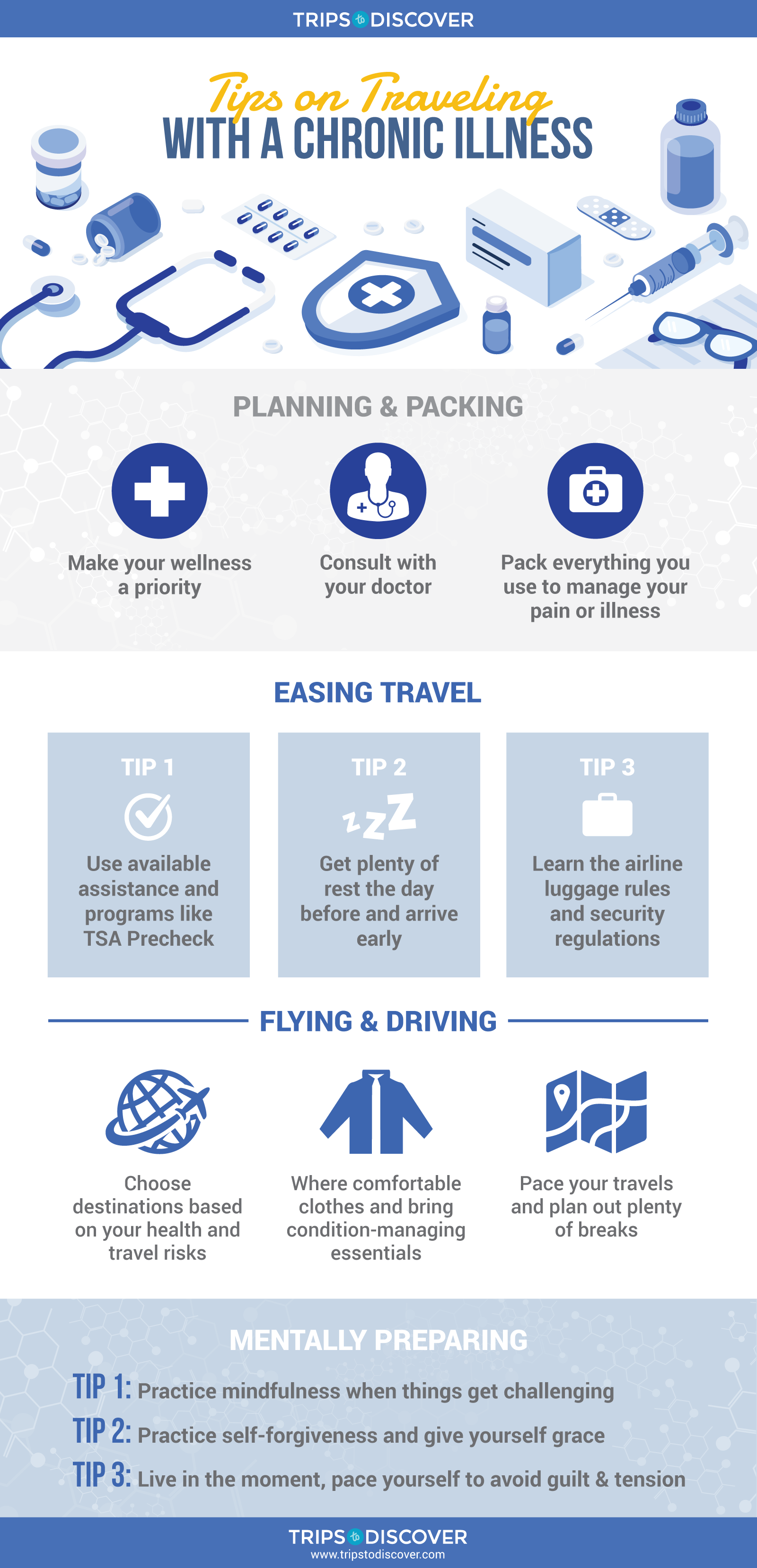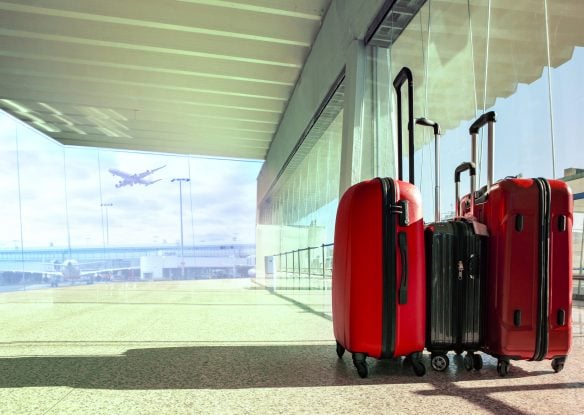Living with chronic pain or a chronic condition does not have to mean living without travel. A trip can sound overwhelming when living with chronic conditions if daily routines are already challenging. However, by planning, packing the right stuff, taking advantage of programs and accommodations and utilizing a few expert tips, traveling with chronic conditions is not only 100% possible but thoroughly enjoyable if done correctly.
We requested the advice of two experts background-rich in physiotherapy and patient health advocacy on managing chronic conditions while traveling.
Here is a breakdown of everything you will learn on this page:
- Planning to Travel with Chronic Conditions
- Packing to Travel with Chronic Conditions
- Easing Travel with Chronic Conditions
- Flying or Driving with Chronic Conditions
- Mentally Traveling with Chronic Conditions
- Infographic: Traveling with Chronic Conditions
This article is for informational or educational purposes only and does not substitute professional medical advice or consultations with healthcare professionals.


Planning to Travel with Chronic Conditions
Kristina Kasparian, Ph.D., writer, entrepreneur, scientist and health activist, suggests that long before you travel, you should consider what limitations you need to plan for when planning travel itineraries and accommodations and to give your wellness priority.
“Know your body and what triggers pain flares or other debilitating symptoms,” Kasparian advised. “Think about whether you may need to schedule downtime between day trips or stay in one place for longer to give yourself time to recuperate… Consider discussing your expectations/limitations with your travel companions so that you are able to take care of your own needs without friction or tension created with those traveling with you who don’t have the same constraints you do.”
Kasparian suggests one way to help manage all of this is to get support, especially by checking in with your healthcare provider(s) before your trip.
“Your doctor is able to discuss potential risks with you based on an overall view of your condition,” Kasparian said. “How stable it is, and how risky the destination might be for your condition, for example, if you are immunocompromised. Ensuring you have access to healthcare abroad and that your condition is well known and well understood would be key to reducing some of the risks.”
After ensuring your plans are adequately accommodating and set to your pace, it’s important to focus on packing all condition-related management essentials, Kasparian advised. You will want to ensure you have everything you typically use daily to manage your pain or illness.

Packing to Travel with Chronic Conditions
Packing for travel with chronic conditions will look different for everyone, and it is essential to know what your body needs and to pack for each contingency, Kasparian said.
“Pack anything you would use at home to manage your pain or illness, Kasparian advised. “Including comfortable clothing and shoes, medication and any essentials that enhance your comfort.”
Kasparian also emphasized the importance of keeping your management tools close during your travels, particularly in your carry-on if you are flying.
“[Pack] any medications, any essentials you could not live without or easily find there [at your destination] if your checked-in bag is lost or delayed,” Kasparian said. “A list of allergies or a note with your medical condition, in case of emergency. Anything that would enhance your comfort on the flight and upon landing.”

Easing Travel with Chronic Conditions
Aside from bringing pain or condition management tools, you can take a few additional measures before departure to add comfort to your experience.
Lalitha McSorley, owner and lead physical therapist at Brentwood Physiotherapy Calgary in Alberta, Canada, suggests using available assistance to make life easier when traveling with chronic conditions.
“Programs or memberships that may be helpful for those living with chronic conditions include TSA PreCheck for expedited airport security screening and disability travel organizations that provide assistance and accommodations for travelers with disabilities,” McSorley advised. “To navigate airports and security lines more easily, those living with chronic conditions can request special accommodations such as wheelchair assistance or a TSA notification card to alert security personnel to any medical devices or supplies.”
Kasparian added that it is crucial to arrive before a flight with extra time if you need it to best prepare for crowds or unexpected situations like a flare-up.
“Make sure you are well rested before you arrive at the airport so that you can be focused and you can have enough energy to navigate the demanding environment (in terms of noise, stimulation, fast pace, etc.),” Kasparian said. “Make sure you know the airline’s luggage rules and that you are in compliance with security regulations to avoid unnecessary delays at security. Check in for your flight as soon as this option becomes available and, if possible, select your seat by considering your health condition.”
Kasparian said to keep in mind how often you will need lavatory access, the frequency of standing and stretching during a flight, and if leaning on a window seat maximizes your comfort.
Kasparian also advised printing your boarding pass and saving it on your phone (as a document or a screenshot) to ensure movement through the airport goes smoothly.
“When navigating the airport, be sure to ask for assistance without feeling self-conscious if you need it,” Kasparian said. “Some disabilities are invisible! But you are entitled to assistance or additional time if needed. If you think you need more time to board, let the staff at the gate know that you would like to board immediately after the priority passengers before general boarding begins. Navigating airports smoothly requires proactiveness (preparation + knowing yourself) and energy.”

Flying or Driving with Chronic Conditions
McSorley said some chronic conditions could place individuals at higher risk during air travel, including heart or lung disease and blood clotting disorders.
“These conditions can increase the risk of developing blood clots or experiencing difficulty breathing at high altitudes, McSorley said. “To alleviate these risks, travelers can take measures such as wearing compression stockings, staying hydrated, and moving around periodically during the flight. It may also be helpful to consult with a doctor before traveling to discuss any special precautions or accommodations needed.”
Kasparian emphasized the importance of choosing a destination based on your health and associated travel risks while considering travel advisories.
“Make sure you would have access to healthcare or to a pharmacy at the destination (and that you would be able to communicate, an official doctor’s note could help) and that you have access to your coping mechanisms to alleviate some of your pain or flared symptoms,” Kasparian said. “Make sure any medication you travel with is packed with you in your carry-on baggage and not checked in on the flight. Also, make sure to have a list of your allergies and emergency contacts in your wallet.”
Wearing comfortable clothes and choosing a seat that maximizes your ease is highly important when flying, Kasparian advised.
“Know what postures trigger your pain and try your best to avoid them by standing up to do some exercises in the back of the plane,” Kasparian said. “Mention to flight attendants that you have a health condition and that you sometimes might need to stand or stretch, etc. Speak to your doctor to see if there is any medication or relaxant to facilitate your flight and its effect on your body.”
“Someone experiencing chronic pain can fly more comfortably by bringing along supportive cushions or pillows,” McSorley added.
McSorley said that much of the same advice also applies to car travel.
“Take breaks every hour or so to stretch and move around, bring along supportive cushions or pillows, and consider using assistive devices such as a back brace or lumbar support,” McSorley said.
Kasparian pointed out additional tips for traveling by car while living with a chronic illness, condition or pain.
“Plan breaks to stretch, hydrate, go to the bathroom and make sure to eat well (and slowly) so as to keep your nervous system in check to avoid flares,” Kasparian said. “Do not rush! Pacing yourself is key.”
Lastly, both our experts recommend looking at travel insurance policies.
“You never know when you may need it,” Kasparian said. “Depending on the destination, hospital visits and medication can get pricey. It’s extra peace of mind, which is always a win in my books!”

Mentally Traveling with Chronic Conditions
While preparing everything on the outside and for the future, don’t forget to look inward presently. Mindfulness can have positive effects on the nervous system, Kasparian said.
“Chronic or persistent pain is triggered when the nervous system is in flight or fight mode when it perceives danger, Kasparian said. “It helps to make sure that, during travel and while at your destination, you pace yourself and live in the moment to tell your brain that there is no threat and that it can lower its guard and avoid a crisis.”
Not everything will always go according to plan; Kasparian advises practicing self-forgiveness when things happen.
“Give yourself grace; it’s not all or nothing,” Kasparian said. “You can do something but come back early (rather than doing it to the point of exhaustion or not doing it at all). Approach your trip with a mindset of self-acceptance. Removing that layer of guilt or tension can help you better enjoy yourself and also helps your nervous system shift its perspective away from crisis mode.”



















































